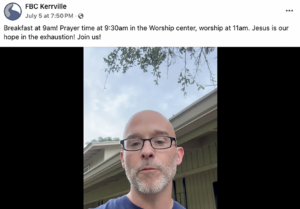
NASHVILLE, Tenn. (BP)–Beginning in the summer of 2003, the nation’s homosexual activists piled up victory after victory, leaving pro-family leaders concerned — the U.S. Supreme Court struck down anti-sodomy laws, the Massachusetts high court legalized same-sex “marriage” and the U.S. Senate failed to pass a constitutional marriage amendment.
In hindsight, homosexual activists may have triggered a backlash that does their cause more harm than good.
President Bush won re-election Nov. 2, and exit polls suggest that same-sex “marriage” may have been the deciding factor.
Especially in Ohio.
The state that ended up deciding the presidential winner had a constitutional amendment on the ballot to ban same-sex “marriage.” It passed overwhelmingly by a margin of 62-38 percent, and apparently brought out thousands of Christian voters who either had never or rarely voted.
According to exit polls, 25 percent of Ohio voters called themselves evangelical — a number higher than the national figure of 22 percent. Among those Ohio evangelicals, 76 percent voted for Bush.
Compared to 2000, the 2004 election in Ohio saw an additional 900,000 voters cast ballots. Bush won this year by some 136,000 votes.
Could the amendment have been the difference? It’s possible. During the campaign to pass the amendment, churches and pro-family groups were involved in registering 54,500 new voters. Thousands more, who were registered but rarely voted, are thought to have voted for the amendment, and subsequently for Bush.
“I had seen polling data from six months ago that if this was on the ballot, that it would help the president by 3 to 5 percent,” said Phil Burress, who as chairman of the Ohio Campaign to Protect Marriage organized a petition drive to place the amendment on the ballot.
“But that’s not why I did it. I did it to protect marriage. Apparently, it did have an impact.”
Ohio was one of 11 states to vote on constitutional marriage amendments on Election Day. All of them passed. The amendments were driven by events of recent months, beginning last November, when the Massachusetts high court handed down a ruling legalizing same-sex “marriage.” It took effect in May.
Elsewhere, the mayor of San Francisco earlier this year ordered city officials to issue marriage licenses to same-sex couples, in defiance of state law. In Oregon, commissioners in the state’s most populous county voted to do the same.
The victories by same-sex “marriage” supporters left pro-family groups on the state level promising that it wouldn’t happen in their state.
Ironically, the marriage amendment push was sparked by events in Kerry’s home state of Massachusetts.
“The credit for this has to go back to the Massachusetts Supreme Court, because if they had not ruled on same-sex ‘marriage,’ we would not have put this on the ballot,” Burress said.
The Ohio Campaign to Protect Marriage collected some 500,000 signatures to place the amendment on the ballot, and it mailed out 2.5 million pro-amendment bulletin inserts to thousands of churches across the state.
In the days leading up to the Nov. 2 vote, the organization asked churches to call their members and urge a “yes” vote on the amendment. In addition, the Ohio Campaign to Protect Marriage placed an automated phone call to every household in the state — 2.9 million — and identified 850,000 amendment supporters, Burress said. On the day before the election, each of those supporters received a phone call with a recorded message from Secretary of State Kenneth Blackwell encouraging them to get out and vote for the amendment.
For years, Burress has been trying to get churchgoers to the polls. Finally, he said, it worked.
“I’ve been in the pro-family movement for 21 years, and we’ve been preaching this [pro-family] message and trying to get the church out to vote and trying to get them to be a values voter,” he said. “This year it resonated.”
The support for the amendment was widespread. Burress said he even heard reports that the Amish — who rarely vote — registered simply to vote for the amendment.
“They said, ‘We’re voting in this one.'”
Others felt the same way.
“A lot of elderly people had said that they had never voted before,” Burress said. “This did it.”
The feeling among pro-family groups today stands in stark contrast to how they felt late last year. In June 2003 the U.S. Supreme Court handed down its Lawrence v. Texas decision overturning anti-sodomy laws. That same summer, the first provinces in Canada legalized same-sex “marriage.” A few months later, Massachusetts’ high court issued its ruling.
Homosexual activists were calling 2003 the “gay year,” and they hoped to continue their momentum with the 2004 election. The major homosexual activist groups endorsed Kerry, who opposed a marriage amendment to the U.S. Constitution and supported civil unions, and even promised to nominate judges sympathetic to their cause.
Instead, those activist groups now are faced with perhaps their worst-case scenario — a conservative president with a conservative-leaning Senate. Both are critical in the makeup of the federal courts and the Supreme Court: the president nominates judges and the Senate confirms them.
Both sides in the marriage debate expect that the Supreme Court eventually will take up a same-sex “marriage” case.
“This issue is going to be resolved by the U.S. Supreme Court, and it’s not going to give a [expletive] what these state constitutions say,” Matt Foreman, executive director of the National Gay and Lesbian Task Force, told the Associated Press following the election.
But evangelicals appear to be galvanized like never before. Burress said that the same-sex “marriage” issue has made a bigger impact on political involvement than the abortion issue has.
“What’s going to make a difference with keeping the church motivated is that we have to be proactive,” he said. “People don’t like complaining and being reactive. They want to do something [and] they want to do something positive.
“And this is something that they can do, and that’s why we’re looking forward to next year to find another 10 or 15 states that will put the amendment on the ballot while we continue to work for a change in the U.S. Constitution.”
–30–
For more information about the national debate over same-sex “marriage,” visit https://www.bpnews.net/samesexmarriage















